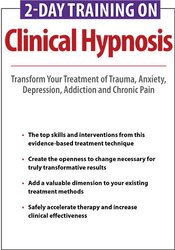

Providing hope and healing is the kind of work that makes you come alive. And you strive to help each client who’s counting on you to deliver.
But sometimes a lack of focus in therapy brings progress to a screeching halt. And traditional treatment approaches can fail to create the openness to change needed to make the therapeutic experience a life-altering one.
Watch this intensive course recording and get indispensable skills and tools from clinical hypnosis to create the focused, relaxed and attentive context necessary to bring about truly transformative results with your clients!!!
Dr. Eric Willmarth is a past president of the American Society for Clinical Hypnosis, the Society for Psychological Hypnosis (APA Div. 30), and the Society for Clinical and Experimental Hypnosis.
Watch him as he shares the skills and techniques he’s found most effective during his decades of clinical work.
He’ll teach you the core skills of hypnosis and provide you with step-by-step instructions and demonstrations on hypnotic techniques that will amplify the effectiveness of the therapeutic modalities you already work with.
Add valuable dimensions to your treatment toolbox, and feel more capable and confident in helping your clients conquer their anxiety, depression, pains, addictive behaviours and traumatic pasts!
| File type | File name | Number of pages | |
|---|---|---|---|
| Manual - 2-Day Training on Clinical Hypnosis: Transform Your Treatment of Trauma, Anxiety, Depression, Addiction and Chronic Pain (6.9 MB) | 159 Pages | Available after Purchase | |
| Manual - 2-Day Training on Clinical Hypnosis: Transform Your Treatment of Trauma, Anxiety, Depression, Addiction and Chronic Pain - French (6.9 MB) | 159 Pages | Available after Purchase | |
| Manual - 2-Day Training on Clinical Hypnosis: Transform Your Treatment of Trauma, Anxiety, Depression, Addiction and Chronic Pain - Italian (6.9 MB) | 159 Pages | Available after Purchase | |
| Manual - 2-Day Training on Clinical Hypnosis: Transform Your Treatment of Trauma, Anxiety, Depression, Addiction and Chronic Pain - German (6.9 MB) | 159 Pages | Available after Purchase | |
| Manual - 2-Day Training on Clinical Hypnosis: Transform Your Treatment of Trauma, Anxiety, Depression, Addiction and Chronic Pain - Spanish (6.9 MB) | 159 Pages | Available after Purchase |

Eric K. Willmarth, Ph.D., is the president of the Society for Psychological Hypnosis (APA Division 30) and a past-president of both the American Society of Clinical Hypnosis and the Society for Clinical and Experimental Hypnosis. He has used hypnosis in clinical practice for over 40 years, including over 30 years in a chronic pain management setting.
Dr. Willmarth is the chair of the department of applied psychophysiology department in the College of Integrative Medicine and Health Sciences, Saybrook University. He oversees the hypnosis certificate program at Saybrook, which involves basic, intermediate and advance hypnosis courses and he is a frequent presenter and Keynote speaker at national and international hypnosis conferences and workshops. He is the winner of the Distinguished Contributions to Professional Hypnosis Award from the American Psychological Association and the Ericka Fromm Excellence in Teaching Award from the Society for Clinical and Experimental Hypnosis.
In addition to his teaching, Eric has recorded hundreds of interviews with prominent hypnosis clinicians and researchers from around the world. Many of these video clips can be viewed at
Speaker Disclosures:
Discover the Core Skills of Hypnosis
Methods to Elicit a Trance Experience: Increase Focus and Relaxation to Intensify Therapy
How to Structure a Hypnosis Session
Hypnosis Skills and Techniques for Specific Disorders and Conditions
Trauma: Restore Control and Process Traumatic Memories
Anxiety: Shift Clients to Calm with Hypnotic Suggestion
Depression: Breaking the Cycles of Depression
Acute and Chronic Pain: Interventions to Change Clients’ Minds and Pain
Addiction: Release Clients from Addictive Behavior Patterns
Experiential Workshop: Elicit a Trance State for Enhanced Responsiveness in Therapy
Please wait ...